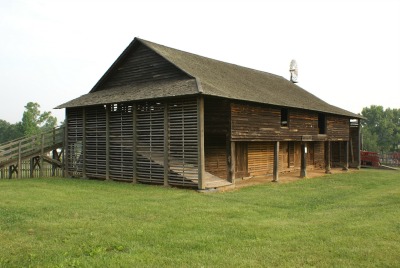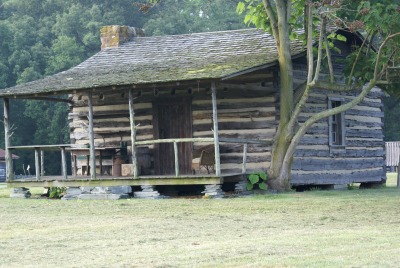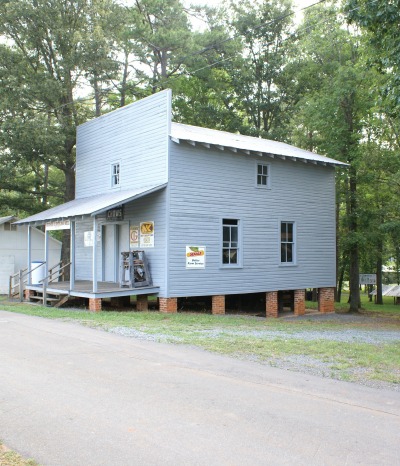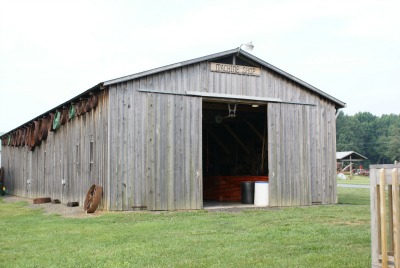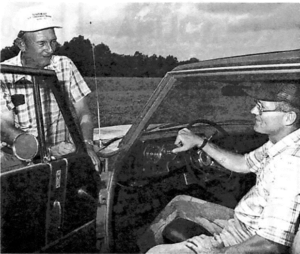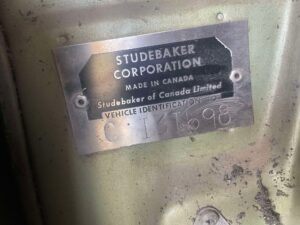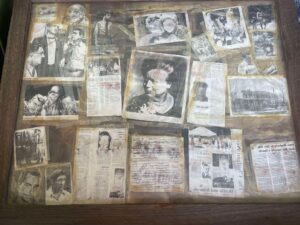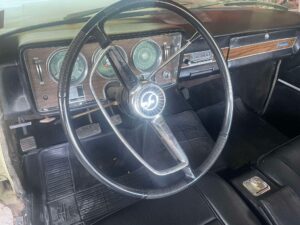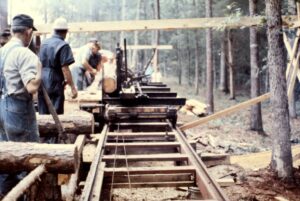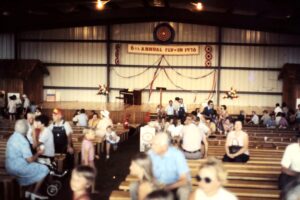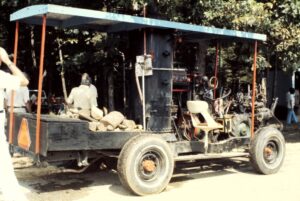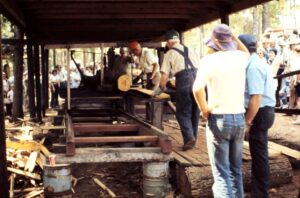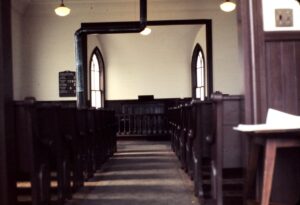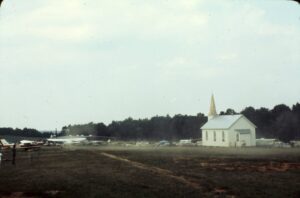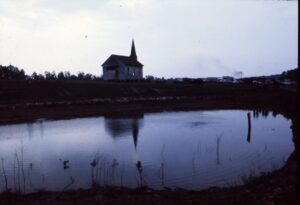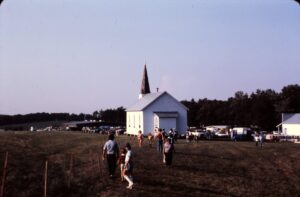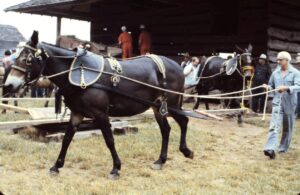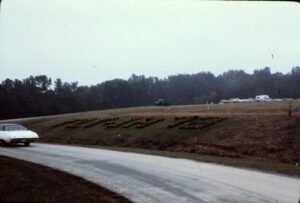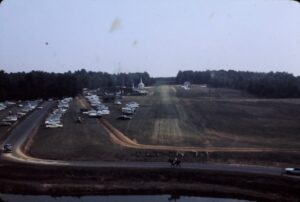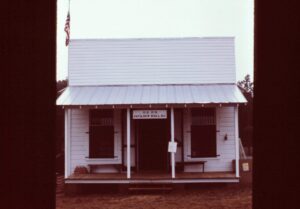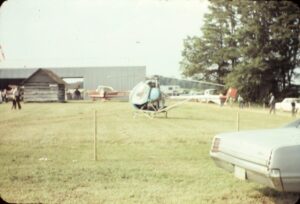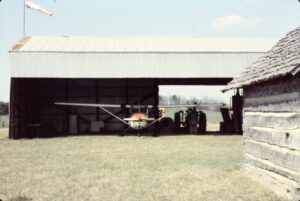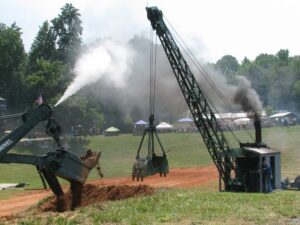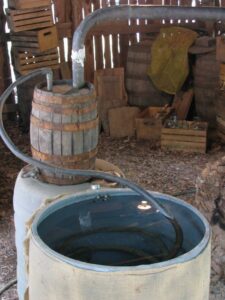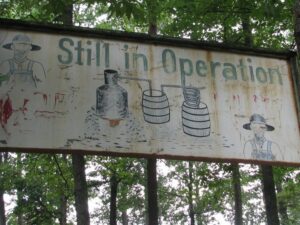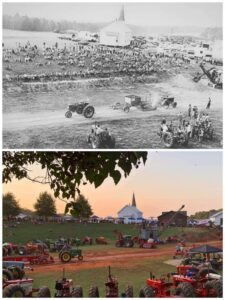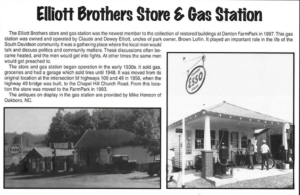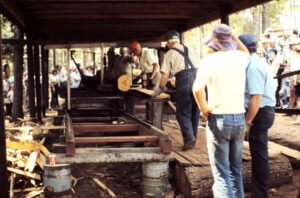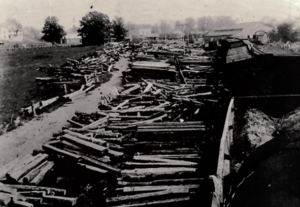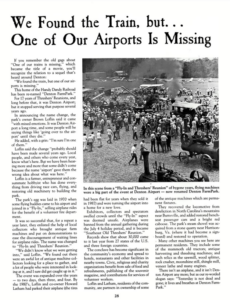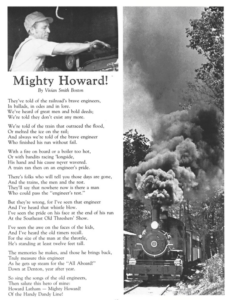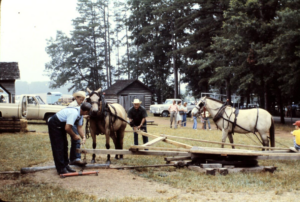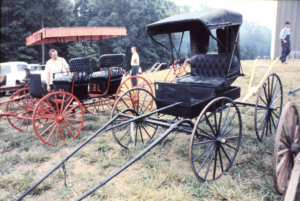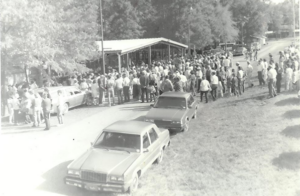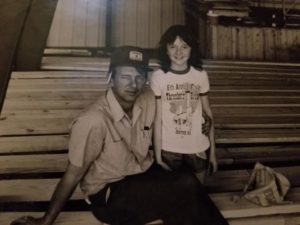
History of the Denton FarmPark
Denton, NC 27239
In 1970, Denton FarmPark’s Owner, Brown Loflin was driving and came upon a local rescue squad member who was having problems with a lighting generator. A conversation ensued about where the funds for fixing the generator were located and an idea was hatched in the mind of Brown Loflin. Loflin, a lifelong resident of the Handy community, is an entrepreneur and the consummate hobbyist. He has been involved in driving race cars, flying, politics, and restoring old machinery to building the park. He is the organizer and director of the Southeast Old Threshers Reunion. As a flying enthusiast and the co-owner of an airplane he had the idea of having a “Fly-In” to help the rescue squad buy some much needed equipment. Together with the other co-owner of the airplane- Howard Latham, J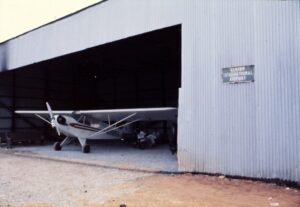 oe Graves, and other pilots, the First Fly-in was held on July 4, 1970. They offered airplane rides for a price and a meal of chicken pie and green beans for sale. It was a Smashing Success! The lines for the plane rides became extremely long that another idea was to add a demonstration of wheat threshing to ese the impatience of people waiting for the plane ride. The name of the event was changed to the “Fly-In and Threshers Reunion”. That move was very Successful, because it became evident that there were many collectors who wanted a place to show their collections. “We didn’t know what we were getting into,” Loflin recalled. “We found out there were a lot of antique machinery collectors looking for a place to gather, and a lot of people who were interested in looking at it, and we sure did get caught up in it.” A myriad of other shows were visited throughout the nation to gather ideas for what would become the area’s largest event. The Event expanded over the years from one, two, three, four, to now Five days.
oe Graves, and other pilots, the First Fly-in was held on July 4, 1970. They offered airplane rides for a price and a meal of chicken pie and green beans for sale. It was a Smashing Success! The lines for the plane rides became extremely long that another idea was to add a demonstration of wheat threshing to ese the impatience of people waiting for the plane ride. The name of the event was changed to the “Fly-In and Threshers Reunion”. That move was very Successful, because it became evident that there were many collectors who wanted a place to show their collections. “We didn’t know what we were getting into,” Loflin recalled. “We found out there were a lot of antique machinery collectors looking for a place to gather, and a lot of people who were interested in looking at it, and we sure did get caught up in it.” A myriad of other shows were visited throughout the nation to gather ideas for what would become the area’s largest event. The Event expanded over the years from one, two, three, four, to now Five days.
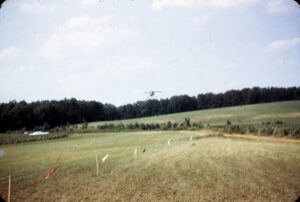
Construction over the 40 plus years has changed the Denton Airport, which was a grassed runway with an open-sided shelter as a hangar for the airplane, into a virtual small town with a 15,000 square foot exhibition building, a covered pavilion for music, a restoration shop with much equipment used for the restoring of machinery of all shapes and sizes, a second exhibit building called the craft barn, a general store, a church, machine shop, service station, doll museum, grist mill, bath and restroom facilities, and other structures for dispensing food and beverages. Recent Reunions have brought 55,000-plus to Denton FarmPark.
The Steam Shovel was brought to Denton FarmPark and Painstakingly restored after being used as a fixture on a billboard in Harrisonburg VA in 1976. It is a popular exhibit. The original shovel operator was Mr. Willard Moore who passed away in March of 2011.
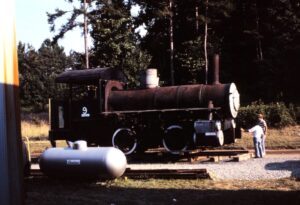
In 1979, a steam locomotive was Purchased from Dave Bernhardt and Associates in Mt. Pleasant, NC. It was then brought to the Denton FarmPark from Burnsville, NC. It was restored along with three passenger cars, a tender and a caboose. The path of the railroad Tracks was prepared and placed on the ground with the help of Fred Russell, Charles Johnson, Dee wright, Howard McCullen, Danny Wagner, and of course the two Howard Latham and Brown Loflin. Latham (co-owner of the airplane) may have been harboring a desire to be a railroad engineer. Taking vacation during the Reunion, with a traditional striped cap and red bandana, he drove the steam locomotive on the park’s standard gauge Handy Dandy Railroad. “It’s hard work and hot,” he said, “but it’s also fun when I see how much it’s enjoyed by kids from 2 to 92.” The Handy Dandy Began operations at the Denton FarmPark in 1982. It is one of the more popular attractions during the Southeast Old Threshers Reunion.

In the 1980s the airplane that had been instrumental in the fly-in was parked and eventually sold to Joe Graves. Unfortunately the plane was destroyed several years later by a hurricane in Florida. Concentration on the Threshers reunion sored. Attendance increased to the point that airplanes and machinery did not mix. Airplanes were banned and the event changed its name to the present Southeast Old Threshers Reunion.
In the late 1980’s the Denton Airports name changed to Denton FarmPark to keep up with the changing emphasis. The name change came with mixed emotions. Many local people who came every year knew what was here as Denton Airport, but lots of people would not come because the word “airport” gave them the wrong impression of what was here. It was actually not an airport anymore.
The Southeast Old Threshers Reunion is a national and international event. Attendees come from nearly every state and at least one foreign country is represented. The Southeast Old Threshers Reunion plays a significant part of the Denton area economy and spreads to hotel and restaurant accommodations in Davidson County. Civic, church and charity organizations benefit from the sale of food and refreshments and other activities, and from contributions by their park for services by volunteers.

Since 1984 The Denton FarmPark hosts a pageant and Crowns a Southeast Old Threshers Reunion Queen Every year during the Southeast Old Threshers Reunion the first week of July. The winner of the pageant receives a scholarship thanks to generous sponsors to help with the Queen’s education and represents the southeast Old Threshers Reunion at other events throughout NC for the year.
Bates-Corliss Engine
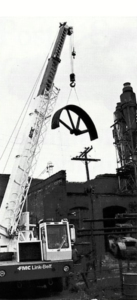
The monstrous steam engine made in 1905 sits next to Denton FarmPark’s exhibit hall. It was moved here in May of 1988 from Maxton, N.C., for restoration. It was derelict for half a century..
Threshers’ Reunion director Brown Loflin said he believes it will be the largest steam engine running on public display in North Carolina “and I’m sure it’s one of the biggest in the United States.”
The 24-foot-long Bates-Corliss engine and its boiler weigh 125,000 pounds. Its eight-spoke flywheel, 15 feet in diameter and 30 inches wide, is 32,000 pounds of cast iron in two parts. Runs at 350 horsepower and was the company’s primary power source until it was abandoned in 1938.
Loflin said he and a crew spent “about 24 man days” in preparation for the antique’s 100-mile trip. When they started, it was buried under tons of discarded. machinery in a burned-out building scheduled for replacement at Maxton Oil and Fertilizer Company.
“The clean-up took two days,” Loflin said, “and we had five more days of flooring and shoring and dismantling the engine into six big parts and a lot of little ones. When you’re dealing with bolts four inches in diameter and five feet long, and nuts on them have been rusting for 50 years, it doesn’t come easy.”
A 50-ton crane, 10-ton fork lift and four tractor-trailer rigs were used in the removal and hauling. Thirty cubic yards of concrete have gone into the engine’s new foundation.
“Now we have to put it back together and make it run,” said Loflin, “and that’s the part of the job that gets really tedious.”
Return to operation required replacement parts, he said, “and we couldn’t go to the store and buy them. They had to be made. We have done most of the work in our restoration shop, and contracted some of it.”
Similar tasks have been performed here with a variety of antique machinery, including giant farm tractors and the steam train on the Handy Dandy railroad.
Loflin said he hoped to have the engine running at this 18th annual Threshers’ Reunion.

“We’ll at least have it put back together and on display,” he said, “and we’re going to do everything we can to have it running. That will depend on how much trouble we run into with repairs. Everything you do to it is a big job.” The engine was donated to the park by the Maxton company, whose co-owner Murphy Evans said he is “very happy it can become a historical preservation. It’s at piece of my family’s history. We could. have sold it as scrap iron, but I’d rather know it’s bringing enjoyment to people.”
General manager Ed Stevenson said. records show the engine was installed new in 1905, four years after the company was founded, and was its principal power plant until abandonment in 1938. The “oil” in the company’s name refers to extraction and processing of oil from cotton seed and peanuts, major crops in the farming area. where the Robeson County plant is located. The Bates-Corliss Engine was restored in 1989
In 1989, Loflin could resist any longer! His ambition was to rescue the deteriorating buildings of a plantation which pioneer The Richmond Reid Plantation on the waters of Cabin Creek and the Yadkin River, 2 miles south of High Rock and 7 miles southwest of Denton, may be called the most remarkable farm in Davidson County. In the first place, it is the only farm in the county still in operation where every sizable building was erected before the Civil War. Secondly, it is the birthplace and boyhood home of Dr. Albert Clayton Reid, who taught philosophy at Wake Forest University for 45 years and may well be the most distinguished teacher that Davidson County ever produced. Thirdly, it is the only farm in Davidson County that has ever been used as the backdrop for a book. The book is a delightful little novel entitled Tales of Cabin Cook. Cabin Creek is a small stream that rises about 5 miles southeast of Denton, then meanders westward for some 10 to 12 miles passing through Dr. Reid’s ancestral farm to join the Yadkin River.

The old plantation is a relic of the old South. So far as known, it is the only farm in NC now in a high state of cultivation, where every sizable building on the place was erected before the Civil War. One approaches the Reid Plantation, if one goes from Denton by motoring South over Jackson Hill Road for a little over 4 miles then turning West into Lick Creek Road and proceeding for a little over 2 miles, then turning southwest over a dirt and gravel road, and proceeding through the woods and fields for about a mile. At the end of this road, on a hill about a quarter of a mile from where Cabin Creek joins the Yadkin River, stands a group of antique buildings dating from a time when millions of American people still believed that slavery was a divinely ordained institution and when nobody in Illinois even expected Abe Lincoln might one day be President of the United States. Most conspicuous of these holdings is a fine two story farmhouse vacant for 20 years except for furniture which has in its day housed 3 generations of the Reid’s. Built of heat pine by Richmond Reid, it is still well preserved. Near the ancestral home is a smaller 2 story house part of which served as a kitchen. Someone, at the big fireplace prepared food for Richmond Reid and his family. The second story served as a weaving room in for those employed. It is now the home of Henry McDowell and his wife who have cared for the plantation for many years. Other buildings within a convenient distance from the dwelling are a smokehouse, granary, and a large 2 story barn all substantially built and put together with wooden pegs.
In the nearly 40 years since the publication of this article, the Reid Plantation changed as one might suspect. The health of Mr. and Mrs. McDowell deteriorated to the point that they were unable to care for the plantation. They were eventually moved to health care facilities. With no one to look after the plantation, vandals took their toll on the buildings. As a result of this and with the concern of others, Denton FarmPark’s director, Brown Loflin, acquired the buildings that remained intact from the descendants of Richmond Reid and moved them to Denton FarmPark in the 1980’s. They were lovingly restored to their original luster for all.
He obtained the buildings from Reid’s descendants, who welcomed preservation, and he and park employees worked months on preparation and moving the plantation to the park. A “Workers kitchen” where “the help” slept upstairs and prepared food downstairs for the plantation’s virtually self-sustaining community, is the latest restoration of those buildings.
 Restored earlier: a “tramping barn,” where Reunion visitors see horses thresh wheat with their hooves; a granary; and blacksmith shop where you can watch a smith pump his bellows and shape iron.
Restored earlier: a “tramping barn,” where Reunion visitors see horses thresh wheat with their hooves; a granary; and blacksmith shop where you can watch a smith pump his bellows and shape iron.
The “tramping” barn used to be abundant in the country and in its day was the most advanced method of separating the grains of wheat from the stalk and pod. The barn is part of the W.A. Reid Farm plantation, and was moved to Denton FarmPark in the 1980’s. The barn has a long platform slanting up the side of the building leading to a large door into the threshing room. Three or four horses were driven up the ramp and into the tramping room where bundles of wheat were strewn on the floor. The floor consists of boards 2 ½” by 2 ½” that are placed about an inch apart to allow the grains of wheat and chaff to drop through into a bin on the first floor.
Once the horses were in the tramping room, an attendant, usually a slave, was put in charge. He kept the animals moving with a whip in one hand and a bucket in the other. The constant pounding of the horses’ hooves and pressure from the weight caused the separation of the grain.
As with most cabins, there is a timeless quality about them. The small cabin at Denton FarmPark, which was one of the first buildings brought to the park and restored, provides this quality. Many are not aware of the history of this cabin, but fortunately, Shirley Terrell of Denton, NC provided enough information for us to share.
This cabin is a typical one room cabin with a large fireplace for cooking and for warmth. The cabin also has a loft. Its original location was off of Old Jackson Hill Road, which is now known as South Main Street Extension in Denton, NC. This cabin was the home of Miss Adeline Loftin.
Miss Adeline was born August 28, 1843 and died November 17, 1942 at the age of 99 and is buried at Clear Springs United Methodist Church in Denton, NC.
Today, the restored cabin is full of life. It houses the collection of antiques which are sold during the Southeast Old Thresher’s Reunion by Danny and Glenda Wagoner of Salisbury, NC. Come by and browse our antique selection as you marvel at the uniqueness of the Adaline Loftin
Cabin.
The General store and post office building built in the early 20th century, was moved here from the nearby Jackson Hill community, and restored in the 1970s.
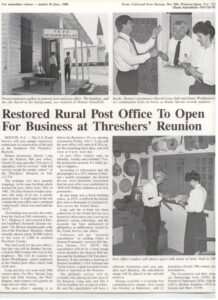
The Old Jackson Hill Church
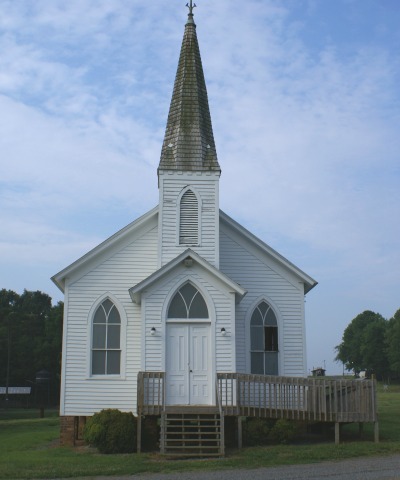 Sometime between the close of the Revolution and 1800, a Methodist Church was established in the Clear Springs area. The church was located to west and north of the intersection of NC Highway 8 and Lick Creek Road. The building was made of logs and stood for many years. About 1825 or prior, a church building was built at Clear Springs near the present cemetery. The building was a frame structure in which services were held once a month, either on Wednesday or Thursday.
Sometime between the close of the Revolution and 1800, a Methodist Church was established in the Clear Springs area. The church was located to west and north of the intersection of NC Highway 8 and Lick Creek Road. The building was made of logs and stood for many years. About 1825 or prior, a church building was built at Clear Springs near the present cemetery. The building was a frame structure in which services were held once a month, either on Wednesday or Thursday.
On April 12, 1883, Richard S. Adderton and his wife Martha deeded one half acre, more or less, in the Village of Jackson Hill to the trustees of the Methodist Episcopal Church, South. A church building was constructed on this site at Jackson Hill and was used for about 25 years.
In 1908, the construction of this church building was completed on the Jackson Hill site. It is the steeple of beautifully designed rural building that inspired the artist, Bob Timberlake, of Lexington, NC to paint his now famous work “Cicero’s Steeple”.
On Sunday, May 6, 1956, Rev. M. Teague Hipps, the District Superintendent, called a Quarterly Conference of the trustees of Jackson Hill Methodist Church for the purpose of granting them the authority to sell the Jackson Hill church building. At the sale, D. Lee Smith purchased the church building and the land on which it stood. After Mr. Smith’s death in May 1976, arrangements were made by the Smith heirs to let the church building be moved to Denton FarmPark to be restored and preserved.
The George E. Sperling Grist Mill was built around 1892 in Shelby, NC. In 1991, the mill was moved from its original location to Denton FarmPark in 1992 (the 100th anniversary of the mill). It was then restored to operation. French stones are used to ground the corn into flour. These stones came from Europe to the United States in the bottoms of ships as a way to stabilize the ship’ s weight. Millwrights chiseled the stones and placed bands around them to make them able to ground the corn. You can buy corn meal here at the Park inside the mill that has been ground on these stones. Its good old-fashioned, stone-ground corn meal is available from 10 a.m. to 6 p.m. each day of the Reunion. Many say that the cornbread that comes from the mill is mighty good!
The Elliott Brothers gas station was moved to the Park in 1993 and was opened to the public in 1997. The gas station was originally owned and operated by Claude and Dewey Elliott, uncles of Park owner, Brown Loflin. Inside the gas station are antiques for sale and the old-fashioned 6 oz. Bottled Coca-Colas.
Beside the Service Station stands the Machine Shop. Inside, one sees the early 20th century machine tool technology in operation. Most of the tools were donated to Denton FarmPark by Vaughn Smith of Woodruff, SC. The line shafts and belt system are examples of how factories were powered before the advent of electricity became available. Such systems would have been powered by a single steam engine, and even prior to that, waterpower.
The display of machines represents what a fairly well equipped working machine shop would have looked like in its time period. The display includes lathes for turning round stock, planers, shapers, and mills for machining flat surfaces, drill presses for making holes, as well as boring mills for machining inside of cylinders or other large round holes. There are also grinders for metal removal. There is a broacher that makes grooves in holes. There is a harness hole puncher, a saw blade sharpener, a plow tip sharpener, an automatic screw machine, and an air compressor. It contains approximately 30 machines that have been restored and are operational.
Aunt Bee AKA Frances Bavier’s Studebaker
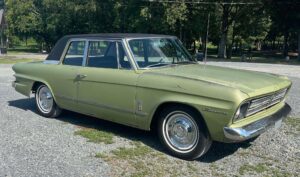
The 1966 model two-door sedan won’t be “restored” in the usual sense of the word, said park owner Brown Loflin as he wiped thick black oil from the engine’s dipstick after the car was brought to the park in June 1990.
“But it’s sure got to have an oil change, and we’ll replace all the old slick tires. It runs pretty good and it will be driven a little, but very little.”
Loflin shares ownership of the car with fellow Denton resident Stan Bingham, who was owner of a lumber company. They paid $20,000 for it at a sale of property of actress Frances Elizabeth Bavier, who portrayed Sheriff Andy Taylor’s aunt Beatrice in television’s Andy Griffith Show.
The car’s six-cylinder engine, made by Chevrolet for Studebaker assembly in Canada, has an impressive label plate: “Studebaker Super Skybolt Six.” Chromed letters on the fenders designate it a “Daytona” model. The odometer indicated it had been driven 44,639 miles when it was hauled here on a truck. The state inspection sticker on the windshield was dated 1982. For most of the time since 1982, it had been stored indoors. There were a few “parking lot dents” and the hood was slightly bent, projecting a little above original position. “We’ll try to straighten that,” said Loflin. “We don’t want to replace it or repaint it. We really feel the car should be kept pretty much the way it was when she drove it.”
Miss Bavier, a New York native, lived at Siler City, N.C., for 17 years until her death last December at the age of 86. The recluse bequeathed personal property to be sold with proceeds going to the state university system’s Center for Public Television. The car’s price was the biggest at the June 2 sale at N.C. State University in Raleigh, where household and personal effects of the actress brought more than $100,000 for the television center at near-by Research Triangle Park.
“We thought the car ought to stay in North Carolina,” said Bingham. “It’s a piece of the state’s history. Brown mentioned the sale to me, and I agreed to go half with him and try to buy it. I’m sure a lot of people will say we paid too much, but we believed it was that important.” What would it have been worth if it hadn’t been owned by the famous actress?
“A thousand dollars at the most,” said Loflin with a chuckle, “and that’s allowing for the fact it’s a collector’s item. But we probably would have gone as high as $25,000 if the bidding had gone that far.”
Bingham, who was doing the bidding, ended it when he topped an offer of $19,500 from a representative of a Studebaker club in Florida. Other bidders included Studebaker collectors from as far away as Texas. Many of the estimated 2,000 at the sale were residents of the area around Mount Airy, N.C., in Griffith’s native Surry County. Many others were faithful followers of the television show, which still is popular in reruns and has nationwide enthusiast clubs.
Griffith, who became a renowned actor after studying drama at the University of North Carolina at Chapel Hill, used recollections of Mount Airy as part of the television series’ stories of homespun life in the fictional town of Mayberry. Although Mount Airy became “Mayberry” and neighboring Pilot Mountain became “Mount Pilot,” the real names of Raleigh 10 and Siler City were mentioned often in the series. Siler City is in Chatham County, about 35 miles east of Denton. Miss Bavier was 69 years old and in retirement when she moved there in 1972.
When she joined the Griffith show in 1960 at the age of 57, she had acted on stage and in motion pictures for many years without the distinction she attained almost immediately in the role of philosophical housekeeper and mother-by-proxy to Sheriff Taylor’s son Opie.
In her Siler City home, after her death, her attorney found her acting contracts. They tracked the career of an actress who earned $75 a week in a 1949 summer theatre to a star who was paid $2,500 for each episode of the Griffith show. Yellowed by age, the contracts were sold – mostly for prices of $300 to $400 each; and one of the millions endeared by Aunt Bea paid $35 for Miss Bavier’s garbage can and its cart. She didn’t have any tractors or threshing machines, but we’re proud to have her Studebaker at the Southeast Old Threshers’ Reunion. It’s like Aunt Bea or a steam tractor in one way: You just don’t see many of them any more.
It was later the Late Brown Loflin obtained the full ownership of the car and after his passing in 2019, the ownership transferred to his Wife Ruby.
If you would like the Studebaker to make a special appearance please email us!
- Brown Loflin (left) and Stan Bingham inspect car of actress Frances Bavier.
The Radio Museum
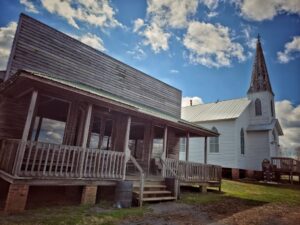
The Radio Museum was built in 2000. It was originally intended to house the radio collection of NC State Senator, Stan Bingham of Denton. While it does still house the 130 radios in the collection, there are many items that have found their way into the Radio Museum. There are Soap Box Derby Cars and other memorabilia from the late Willard Moore of Jamestown, NC. The Derby cars were raced by Mr. Moore’s sons in the 1950’s and 60’s. One , in fact, was raced in Dayton, OH. The toy steam engine collection is on permanent loan to the Park by the family of O’Ryan Sr. and Mary Holen of Winston-Salem, NC. ON the back wall is an extensive axe collection that is on loan to the park in loving memory of Herman Wyrick of Gibsonville, NC. There are also items from the Estate of Frances Bavier, who starred as Aunt Bea on the Andy Griffith Show. There are too many collectibles to mention; come in to discover your favorite for yourself.
Denton FarmPark’s Shoe Shop was built in its current location. It houses many items that would typically be found in a shoe shop that were purchased from the late Sam Morris of Thomasville, NC. There are also other items that call the Shoe Shop home; one of those is a sewing machine that was once owned by the great-great grandmother of the Denton FarmPark’s Director, Brown Loflin. That very sewing machine was used to make uniforms for the Confederate Army during the American Civil War. This is a completely functional Shoe Shop. Denton FarmPark is on the lookout for an individual who knows their way around a shoe shop to demonstrate the art of shoe making and shoe repair during our Southeast Old Thresher’s Reunion.
1898 Cotton Compress
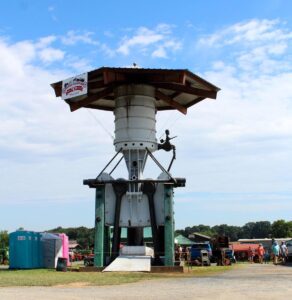
The Cotton Compress originated in Charlotte, NC on North Brevard Street in a rail yard. It weighs 125 tons and is 113 years old. It is the tallest structure at Denton FarmPark. You may be wondering how this gargantuan structure found its way to Denton Farm Park. It was located at a warehouse, that was once one of North Carolina’s longest buildings, that stretched for nearly a quarter of a mile.
Imagine, On a hot day in August 1899, your great-grandparents, passing Brevard Street near 18th, might have seen one of the monuments of Charlotte’s early industrial development under construction next to the Southern Railway tracks. They probably wouldn’t have known what it was – but they would have stopped to stare, because it was an awesome sight: a cast-iron machine the size of an up- ended locomotive, weighting 125 tons, supported by massive 30-foot timbers and topped by a 10-foot-tall piston cylinder – the whole thing driven by steam. The Press, in its heyday, squeezed the moisture and air out of a bale of cotton and reduced its height from 30 inches to 8 or so inches allowing more bales of cotton to be loaded onto train cars to be sent to the cotton mills up North. According to information obtained from the Levine Museum of the New South in Charlotte, in two decades, the Charlotte Compress’s usability increased from just a few thousand bales to 40,000 bales annually. This Press helped propel Charlotte growth into one of the largest cities in the South.
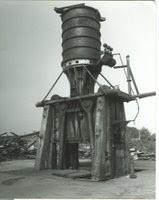
In the hard decades following the Civil War the Charlotte Cotton Compress played a key role in the resurrection of the regional economy. “It was a very proud moment when a smaller community got a cotton press,” says UNC Charlotte historian David Goldfield. Charlotte evolved long ago from a cotton processing and transportation center to an administrative and banking center for the textile industry. The compress sat, unused for 20 years. The Press was given to Denton Farm Park from Cogentrix, a Charlotte, NC Power Company, who had bought to the scrap metal rights on the Press from L and J, Inc., a Columbia, SC Company.
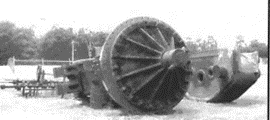
The Charlotte Cotton Compress was an integral part of North Carolina agricultural and textile heritage. It has been dismantled and moved to the Denton FarmPark in Davidson County in 1993. It took 6 weeks, working 16 hour days to dismantle the Press and move it to the Park, according to Brown Loflin, Denton FarmPark Director. Due to other projects at Denton FarmPark, The restoration process didn’t start until 2005 and the Compress was not fully restored to running condition until 2006. Denton FarmPark takes pride in displaying this part of North Carolina history.
CoCa-Cola Museum
Curator, Keith Loflin of the Denton FarmPark, brought has personal collection, of around 7,000, to what is known now as the Coca-Cola Museum in 2017. Loflins interest in the collection was sparked in Mt. Pleasant, Iowa where he and his family were visiting one of the largest antique farm machinery shows in the U.S. There, in the center of town, crafters and antique collectors had gathered in conjunction with the machinery show. As he searched through the numerous booths, something caught his eye. It was a Coca-Cola serving tray. That was his first collectible purchase; at that moment he knew that he had found his hobby. It is known to be the ONLY Coca-Cola Museum in the state of North Carolina! Loflin considers it an honor to house such a unique collection. Each year year, Loflin will switch the summer collection with the winter collection just in time for the Country Christmas Train.
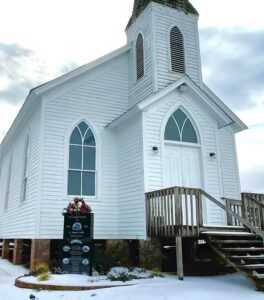
The future: “Bigger and better,” said Loflin. It seems like we couldn’t stop now if we wanted to, and we don’t want to.” Many events call Denton FarmPark their home but if you tell someone you are from Denton, most of the time they will say, yes, that is where the Threshers’ Reunion is…Founded in 1970 with one man’s Idea and became a wonderful place to make memories for thousands!
* Brown Loflin Passed away September 10th 2019. The family put up a memorial outside the church for friends, family, and anyone wishing to pay their respects to the Founder of the Denton FarmPark.
